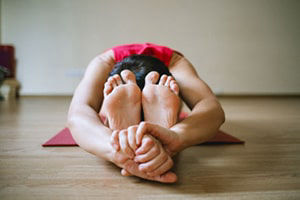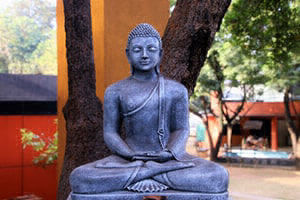
Asana

In Sanskrit, Asana is means "seat," "pose" or "posture." When preforming a sequence of poses known as Yoga Asana, it is important to get into the pose the best to your ability, incorporate the Ujjayi Pranayama, also known as the Ujjayi Breath and if the sequence allows relax into each pose.
Compiling all of the ancient texts together, there are 8,400,000 Yoga poses representing the 8,400,000 incarnations or rebirths that the average individual passes through before the final goal of Self-Realization is achieved.
Over time the great Rishis and Yogis modified and reduced the amount of poses to the few hundred practiced today.
From the few hundred Poses are eighty four that are seen as most useful to practice. With a daily practice, the practitioner has the ability to differ the Karmic process and over step many evolutionary stages in a single span of life.

The ancient Yogis of India discovered that certain poses, because of the position of the body, open the Nadis meaning "energetic pathways" and Chakras of the body. This practice is a tool for higher awareness while giving the practitioner a stable foundation needed for the exploration of the mind, body, breath and higher states.
This practice is often seen as just a way to stretch the body or as an exercise, but that is incorrect. With the practice of Yoga Asanas, a fundamental purpose of the practice is to have an understanding of the workings of the human body and utilizing the poses to move Prana meaning "life force energy" in certain directions.
When the body is healthy and supple how you feel, your out look on life and your energy is at a level that allows for the deeper spiritual practices that this technique provides.
As the practice deepens, the practitioner then understands that this practice is intended to cultivate awareness, relaxation, Dharana meaning "concentration" and Dhyana meaning "Meditation."

In any technique of Yoga, the poses are seen as less effective for Self-Realization, therefore the pose should not be the main practice in a spiritual practice. These poses are known to relax the practitioner while helping to activate the Chakras. During the practice, keep your awareness focused on the practice at hand. Listen to the body and what it needs while feeling what each pose has to offer.
For advanced practitioners, you may that the poses are best for preparing the body for the deeper practices of Pranayama, Bandha, Mudra and Dhyana or Meditation. When the spiritual practice deepens the practitioner typically gravitates towards the higher practices, sometimes abandoning the poses all together or using them to prepare the body.
If you are new to Yoga or new to Yoga as a spiritual path, then the poses can benefit the practitioner by allowing the mind to calm which helps with the deeper practices when they are preformed.